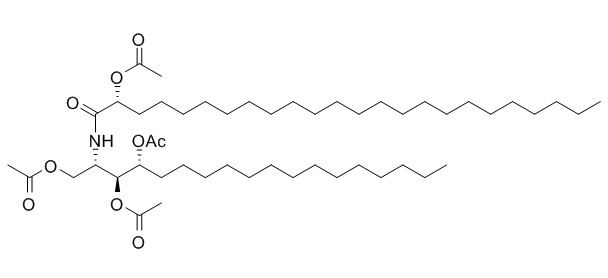2-2'-(Hydroxytetracosanoylamino)-octadecane-1,3,4-triol tetraacetate
(2S,3S,4R,2′R )-2-(2′-Hydroxytetracosanoylamino) octadecane-1,3,4-triol at concentration of 100 ug/mL shows selectively inhibitory activity against phospholipase A 2 (PLA 2) secreted from Crotalus adamenteus venom, but inactive against PLA 2 of bee venom (Apis mellifcra).
Inquire / Order:
manager@chemfaces.com
Technical Inquiries:
service@chemfaces.com
Tel:
+86-27-84237783
Fax:
+86-27-84254680
Address:
1 Building, No. 83, CheCheng Rd., Wuhan Economic and Technological Development Zone, Wuhan, Hubei 430056, PRC
Providing storage is as stated on the product vial and the vial is kept tightly sealed, the product can be stored for up to
24 months(2-8C).
Wherever possible, you should prepare and use solutions on the same day. However, if you need to make up stock solutions in advance, we recommend that you store the solution as aliquots in tightly sealed vials at -20C. Generally, these will be useable for up to two weeks. Before use, and prior to opening the vial we recommend that you allow your product to equilibrate to room temperature for at least 1 hour.
Need more advice on solubility, usage and handling? Please email to: service@chemfaces.com
The packaging of the product may have turned upside down during transportation, resulting in the natural compounds adhering to the neck or cap of the vial. take the vial out of its packaging and gently shake to let the compounds fall to the bottom of the vial. for liquid products, centrifuge at 200-500 RPM to gather the liquid at the bottom of the vial. try to avoid loss or contamination during handling.
Spectrochim Acta A2019, 210:372-380
Environ Toxicol.2024, 39(4):2417-2428.
An Acad Bras Cienc.2023, 95(3):e20220672
Wageningen University & Research2018, January 2018
Molecules.2023, 28(18):6734.
J Sep Sci.2023, 46(16):e2300160.
Food Hydrocolloids2024, 152:109898
Heliyon.2023, 9(11):e21944.
Research Square2023, 2883170.
Mol Biol Rep.2024, 51(1):117.
Related and Featured Products
Chinese Journal of Organic Chemistry, 2003,23(8): 853-7.
Chemical Constituents of the Fungus Leccinum extremiorientale[Reference:
WebLink]
METHODS AND RESULTS:
Thirteen chemical constituents were isolated from the fruiting bodies of basidiomyctes Leccinum extremiorientale, and their structures were elucidated by spectral and physical-chemical data as: ergosta-7,22-dien-3β,5α,6β-triol (1), ergosterol peroxide (2), ergosterol (3), ergosta-4,6,8(14),22-tetraen-3-one (4), ergosta-5,7-dien-3β-ol (5), palmitic acid (6), (2S,3S,4R,2′R)-2-2'-(Hydroxytetracosanoylamino)-octadecane-1,3,4-triol (7), cerebroside B (8), cerebroside D (9), uracil (10), inosine (11), adeosine (12) and D-allitol (13). The NMR data of compounds 8 and 9 were completely assigned by 2D-NMR techniques, including 1H-1H COSY, HMBC and HMQC.
CONCLUSIONS:
Compounds 2, 7 and 8 at concentration of 100 μg/mL showed selectively inhibitory activity against phospholipase A 2 (PLA 2) secreted from Crotalus adamenteus venom, but inactive against PLA 2 of bee venom (Apis mellifcra). In addition, the methanol-chloroform soluble extract of this fungus also showed 67% antifeedant rate against Leucaninia separata and caused 55% mortality against Plutella xylostella after three-day application.
Apterin
Catalog No: CFN95005
CAS No: 53947-89-0
Price: $388/10mg
2'-Rhamnoechinacoside
Catalog No: CFN95035
CAS No: 1422390-59-7
Price: $368/10mg
Rhamnocitrin 3-apiosyl-(1->2)-glucoside
Catalog No: CFN95145
CAS No: 148031-68-9
Price: $318/10mg
3,7,23,24-tetrahydroxycucurbita-5,25-dien-19-al
Catalog No: CFN95168
CAS No: 1446447-97-7
Price: $318/5mg
N1,N5,N10-(E)-tri-p-coumaroylspermidine
Catalog No: CFN95256
CAS No: 364368-18-3
Price: $388/10mg
Tetillapyrone
Catalog No: CFN95404
CAS No: 363136-43-0
Price: $413/5mg
10-Hydroxyaloin B
Catalog No: CFN95454
CAS No: 134863-92-6
Price: $318/5mg
12beta-Acetoxy-3beta-hydroxy-7,11,15,23-tetraoxo-lanost-8,20-diene-26-oic acid
Catalog No: CFN95468
CAS No: 1085338-75-5
Price: $318/5mg
Methyl ganoderenate B
Catalog No: CFN95534
CAS No: N/A
Price: $413/5mg
N-Methyldehydrococlaurine
Catalog No: CFN95588
CAS No: N/A
Price: $318/5mg



